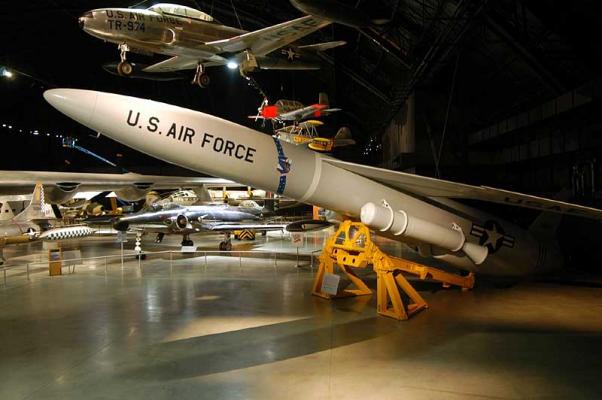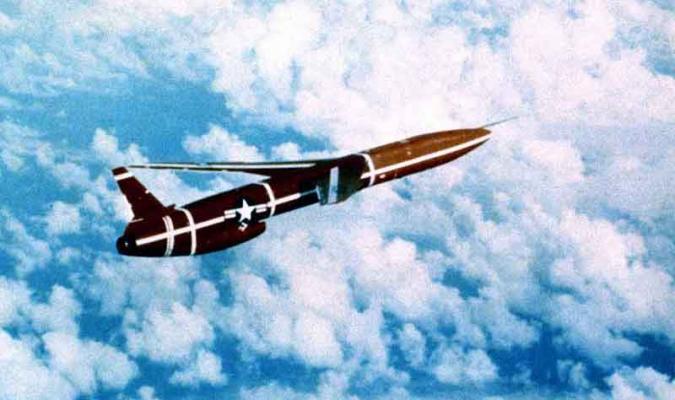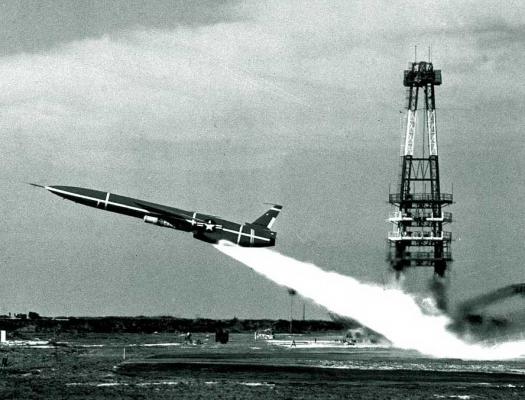A few weeks before the end of World War II, in August 1945, the headquarters of the U.S. Army Air Force (until 1947, the U.S. Air Force was not a separate type of armed forces of the country) announced the acceptance of proposals for the development of a new type of weapons - a subsonic cruise missile capable of reaching a range of at least 8000 km. The best proposal was presented by the company "Northrop Aircraft", which in March 1946 received a contract for research to develop a subsonic cruise missile capable of delivering a nuclear warhead weighing at least 2300 kg at a range of 2400 to 8000 km. The President of the company J. Northrop personally named the new missile "Snark" in honor of one of the literary characters of the writer L. Carroll - snake/shark = "Snark".
However, the new product almost ordered a long life, not yet off the drawing boards designers - in December 1946, on a wave of defense budget cuts, the development program of the CD was almost closed. The program was saved only by guarantees personally provided by J. Northrop to the Army Air Force leadership - the president of the company promised that the missile would be developed in just 2.5 years at a price not exceeding $80000 per piece, if the order for manufacturing by the government is not less than 5000 pieces (this promise, of course, has not been fulfilled by both sides). The main contractor for the development of the missile itself was Northrop Aircraft. Initially, the main contractor for the development of the turbojet engine was the company "Allison". The control system was developed jointly by Northrop Aircraft and General Electric Corporation. The Air Force leadership of the Army planned that the new missile would be an effective unmanned means of destroying the air defense facilities of the USSR (primarily radar) and would ensure the effective overcoming of air defense borders by strategic bombers.
The prototype of the new Snark cruise missile was branded N-25. The missile had an "airplane" layout with a developed boom-shaped horizontal plumage and keel, had a wingspan of 13.1 m with a length of 15.8 m and a takeoff weight of 12.7 tons, was equipped with a TRD J-33. The first flight was planned to be carried out in 1949 from Holloman Air Base (New Mexico), but due to a number of technical problems it took place only in April 1951. Start was held with the use of a special acceleration catapult. Even before the "Snark" first came off the ground, the Air Force toughened the requirements for the new machine. In June 1950, the Air Force issued the following requirements to Northrop Aircraft: to provide the KR with a short supersonic throw at high altitude; to increase the weight of the combat unit to 3200 kg; to increase accuracy until the KVO reached no more than 500 m at maximum range.
To meet the increased demands from the Air Force, J. Northrop ordered the development of an improved version of the RC designated N-69A "Super Snark". The new missile had a takeoff weight of 22.2 tons, a length of 20.4 m, a more powerful engine "Allison" J71 (it was also installed on the N-69B and N-69C). In 1952, the Air Force ordered to curtail test activities at the airbase Hollowman and move it to Patrick airbase, Florida, where the Air Force Atlantic Missile Range was located. However, despite this order, until 1957, it was not possible to fully deploy the tests at the new location (although the first launch of the program took place at the new location in August 1953) due to the constant failure of the timing of commissioning of important test facilities. The test program failed not only due to the fault of the Air Force - in May 1955, at the next test stage it was found that the missile is not able to perform with the required accuracy to "dive" with further hitting the target with an inseparable BC. The contractor had to make numerous changes to the missile design - now the BC was placed in a detachable nose section, and the main body of the CD after the separation of the BC was detonated by a self-destruct system (thus it was planned to create a significant number of false targets, which would make it difficult to intercept the detachable BC). A modified rocket with the detachable BC N-69C was tested in September 1955. In November 1955, the N-69D modification was tested - this modification was equipped with a Pratt & Whitney Corporation J57 TRD and an astroinertial control system (the range of fire was increased by equipping the CR with suspended drop-down fuel tanks). Development of the astroinertial system began in January 1948 on the ground, and in 1951-1958 continued in the air - on B-29 and B-45 bombers. In October 1957, began test launches of pre-production prototypes N-69E KR "Snark". In December 1957, at Patrick Air Base, Florida, was activated 556th Strategic Missile Squadron, designed to train personnel for future staff units.
The Snark tests were very challenging - the number of rockets that crashed and rested at the bottom of the Atlantic was so high that local spearheads dubbed the waters near Patrick Air Base "infected with Snark". The apotheosis that caught the attention of the press was the crash of one of the missiles, which went off course, in the tropical forests of Brazil in December 1956. Naturally, such a string of failures alarmed the SAC Air Force, which was to become the main operator of new equipment. SAC experts indicated that the new missile was extremely vulnerable both on the ground and in flight. In turn, the creators tried to protect their brainchild - in the period 1955-1958. J. Northrop held an aggressive company in the aviation press in defense of the CD "Snark". The main arguments were the following - the lack of need for a large number of expensive air tankers needed for strategic bombers, as well as the lack of need for a large number of trained crews. In addition, the Snark was much smaller and cheaper than the then newest strategic bomber Boeing B-52 "Stratofortress".
However, by 1958 it became clear that the main competitor of "Snark" is not a strategic bomber, and a new type of weapon - intercontinental ballistic missile. By the end of 1958, it finally became clear that the arrival of ICBMs in service is not far off, so the top management of the Air Force expressed doubts about the feasibility of further financial expenditure on the program "Snark". Air Force leadership strengthened its confidence after SAC crews from the 556th Strategic Missile Squadron began test launches of Snark in June 1958 - the missile showed extremely poor performance in terms of accuracy and reliability.
Nevertheless, the logic of the Cold War dictated its laws - back in March 1957, it was announced that the first (in the future it turned out that the only) position area of base for the CD "Snark" will be air base Presquieu Isl (Maine), construction work on which began in May 1956 (the main contractor - the company J.R. Cianchete Construction). The position area was as close to potential targets in the European part of the USSR as possible. In March 1958, the Northrop Aircraft Corporation supplied the Air Force with the first serial missile "Snark", designated SM-62A. The first successful launch of the serial Snark took place in April 1959.
In January 1959, the 702nd Strategic Missile Wing was activated at Preskew Aisle Air Base. The first Snark RC arrived at the base in May 1959 and went on combat duty in March 1960. The 556th Strategic Missile Squadron, which was to become part of the 702nd Strategic Missile Wing and move from Patrick Air Base to Presquieu Isle Air Base, was deactivated in July 1959. Snark research and development was fully completed in December 1960. Fully combat ready base was declared in February 1961 - on combat duty could be maximum 12 KR. However, successes in developing and fielding first-generation ICBMs ("Atlas" and "Titan-I"), combined with successful R&D aimed at creating significantly improved second-generation ICBMs ("Titan-II" and "Minuteman IA/B"), forced the U.S. leadership to pass a final verdict on the Snark. Already in March 1961, U.S. President JF Kennedy ordered the Snark to be removed from service "due to obsolescence and minimal military significance. By the end of June 1961, all Snark missiles were off duty and armed. 702nd strategic missile wing was deactivated at the same time. Despite the fact that the process of development and testing of the rocket took about 15 years, it was in service for just over a year. Given the considerable effort and financial resources spent on the project, the Snark program is not a success.
Composition:
The "Snark" CD was a monoplane with a high arrow-shaped wing (see diagram). There was no horizontal tail fins. The controls are two-section elevons on the wings and a relatively small steering wheel on the vertical tail fins. The fuselage of CD was functionally divided into several parts and was made of aluminum alloys with the inclusion of steel elements. The forward part was equipped with a 4 Mt W-39 thermonuclear warfare unit, which was sufficient for guaranteed destruction of military and political targets in the USSR. The BC combat unit was traditionally developed by the Atomic Energy Commission. This combat unit was designed on the basis of a thermonuclear free-fall strategic bomb B-39. The BC was designed to be detached from the main body. The following maneuver was provided for hitting the target - the CR, flying at an altitude of 15.8 km (cruising ceiling) with a speed of 0.9 M, at a distance of 80.5 km from the target began to accelerate to a speed of 0.94 M with a set altitude up to 18.3 km. After the acceleration was completed, the flight to the target took place, near which the MS was separated by pyrobolts and special stabilizing surfaces were opened on the MS body, after which the MS rushed to the target along a ballistic trajectory (see photo). The main part of the fuselage was then destroyed by special low-power charges in order to create false targets for radar and air defense missile systems. In the forward part of the fuselage was also equipment for checking the automatic detonation of the warhead. During the flight, this equipment checked the automatic detonation of a special test program twice.
In the central part of the fuselage there were intra-fuselage fuel tanks containing JP-4 jet kerosene, the standard fuel for the U.S. Air Force at that time. In addition to the fuselage fuel tanks, there were two dischargeable under-wing fuel tanks with a total capacity of 2245 liters. The tanks, which were placed on special small-size wing units, were located at angles of 4.5° to the vertical plane and 2° to the horizontal plane. The tail end housed a power unit - turbojet engine J57-P-17 of Pratt & Whitney Corporation. The engine was placed in a special fairing in the lower compartment of the tail section. The fairing was equipped with an air inlet and an exhaust nozzle to ensure engine operation. Two solid fuel accelerators mounted on special outboard units in the tail end were also switched on during the initial flight. The accelerators were developed by the Allegany Ballistics Laboratory. The accelerators operated for 4 seconds, after which they were dropped in order to reduce the mass of the missile and reduce its aerodynamic resistance. At the tail end, the astroinertial control system was also placed. The astroblock consisted of three telescopes covered by two flaps. In the case of the flight on the standard program, the astroblock was included in the work twice. Permissible deviation of the rocket from the course during the flight was 120.7 km away from the flight path. With this deviation, the control system could cope with the task of returning the missile to its previous course. During the flight, if necessary, the control system could issue pre-programmed commands for anti-aircraft evasive manoeuvres - up to 8 deviations by 90° from the previous flight direction inclusive. A small air intake was provided for cooling the electronics in the tail compartment at the bottom of the vertical plumage.
The "Snark" missile launch complex at Presquieu Eisle airbase (see diagram) included 6 one-storey hangars, where the missiles attached to mobile launchers (see diagram) were stored, checked and prepared for launch. No more than 5 CDs were stored in each building simultaneously. Rocket number 1 was stored in 15-minute readiness for launch. Rockets Nos. 2 and 3 were in 30-minute and 180-minute launch readiness, respectively. Rockets Nos. 4 and 5 could be ready to launch in no more than 3 and 5 days, respectively. Each hangar was 128*24 m in size. The hangars were at a distance of 137 m each from each other. In front of each hangar there were two launch pads with a diameter of 48.8 m, made of reinforced concrete with a thickness of 25-30 cm. Thus, no more than 12 missiles could be on combat duty simultaneously. The described method of basing had a lot of critics, because even by the standards of the second half of the 50's did not provide proper survival of the strategic system.
In addition to hangars and launch pads, the following facilities were also located at the base: a power station/water pumping station (49*31 m); a test laboratory for TRD (30*19 m); a two-storied command and control building (13*12 m); and a fuel storage facility containing over 57,000 liters of kerosene.
Characteristics:
| Length, m | 20.93 |
| Wingspan, m | 12.86 |
| Height, m | 4.6 |
| Start weight (without overclocking RTDT), t | 22.5 |
| Mass of acceleration RDDT (total), t | 5.15 |
| Speed of cruiser, km/hour | 843 |
| Maximum flight altitude, km | 18.3 |
| Range of fire, km | 8850 (up to 9650 km according to some sources) |
| KVO, km | 2.4 |
| BC power, Mt. | 4.0 |
| TRD traction, kN | 51.1 |
| Accelerated RDTT traction (total), kN | 1160 |
Testing:
On March 26, 1980, during the testing of a prototype projectile with a charge on high-energy ballistic solid fuel launched from the ML-20 base, there was a rupture of the missile part, which damaged the unit. See the electronic image of the photo (front and back) from the family archive of Vyacheslav Ivanovich Podchufarov (Russia, Tula) - participant of those works.
In 1980 Evgeny Alexandrovich Ganichev was awarded the S.I. Mosin Prize for his work on the theme "Development of RSZO "Smerch".
In 2002, the multiple launch rocket system "Smerch" "successfully passed tests in India, during which it confirmed its unique impact characteristics".
Sergei Sivtsov is a designer of control system elements. He made a significant contribution to the development of correcting switchgear for the angular stabilization systems of the Smerch and Hurricane Rocket Launchers. He took direct part in working out of the given elements, tests and their introduction in a batch production.
Sources:
- To defend and deter: the legacy of the United States cold war missile program / by J.C. Lonnquest and D.F. Winkler. USACERL, Champaign, IL, 1997.
- From Snark To Peacekeeper: A Pictorial History of SAC Missiles / by Office of the Historian HQ SAC. OH HQ SAC, Offut AFB, NE, 1990.
- КSAC Missile Chronology 1939-1988 / by Office of the Historian HQ SAC. OH HQ SAC, Offut AFB, NE, 1990.
- Alert Operations and the SAC 1957-1991 / by Office of the Historian HQ SAC. OH HQ SAC, Offut AFB, NE, 1990.
- SAC and the Alert Program: A Brief History / by Office of the Historian HQ SAC. OH HQ SAC, Offut AFB, NE, 1988.
- The Development of Ballistic Missiles in the United States Air Force / J. Neufeld. Office of AF history, USAF, DC, 1990
- US Strategic and Defensive missile systems 1950-2004 / M.A. Berhow and C. Taylor. Osprey Publishing Ltd., 2005.
- www.nationalmuseum.af.mil
- www.globalsecurity.org
- www.fas.org
- www.strategic-air-command.com
- www.astronautix.com






